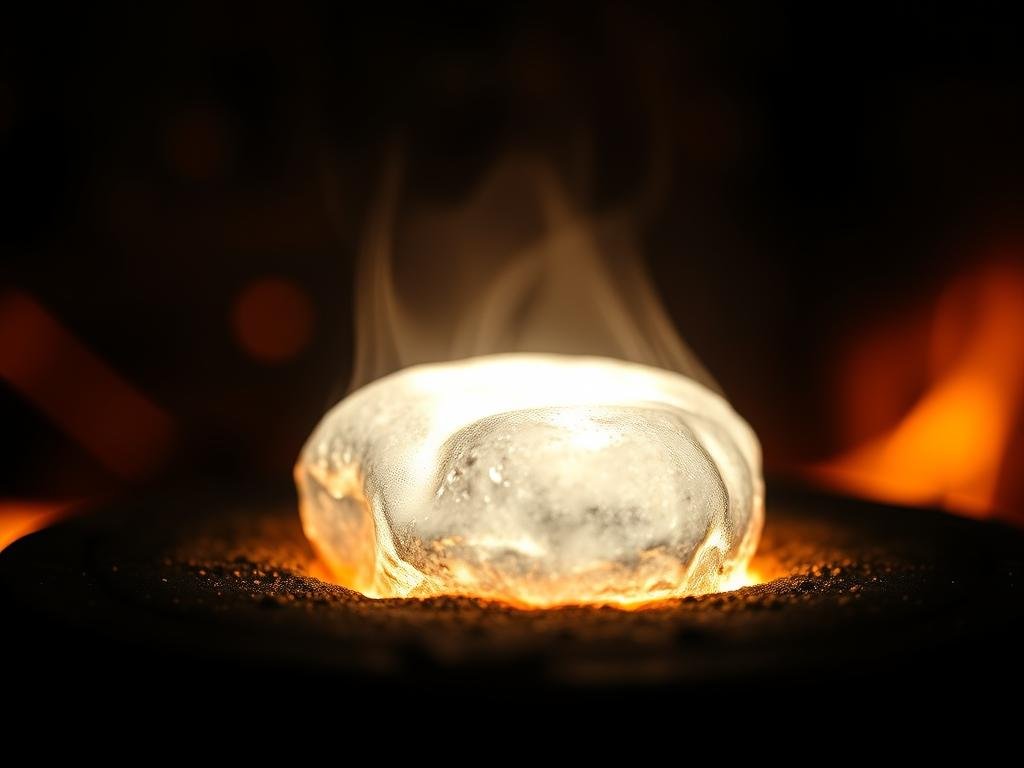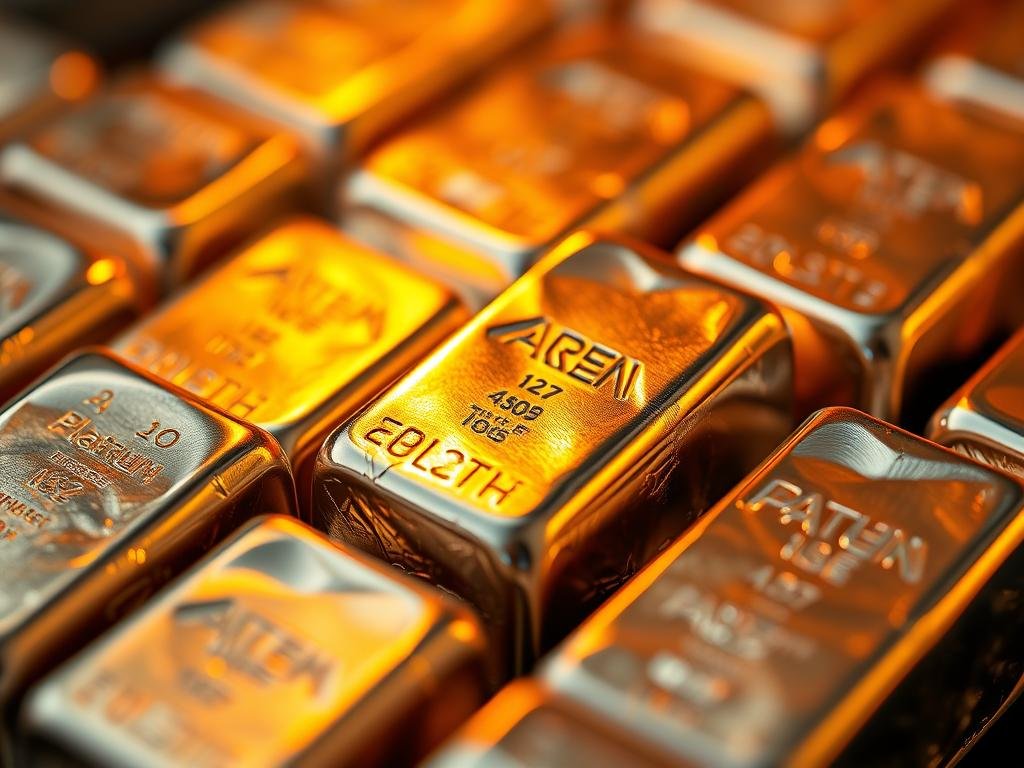البلاتين مشهور بخصائصه الاستثنائية، خاصة ارتفاع نقطة الانصهار of 1772°C, making it an ideal material for applications that require extreme temperature resistance.
This precious metal’s exceptional thermal stability allows it to maintain its structural integrity and performance under conditions that would compromise other metals, such as gold.
With its unique atomic structure contributing to strong metallic bonds, platinum is highly resistant to corrosion, a property that has revolutionized numerous industrial applications.
Understanding the significance of platinum’s melting point provides insight into its premium pricing and critical roles in technologies, from automotive to aerospace components.
The Remarkable Properties of Platinum
Platinum’s remarkable attributes are the foundation of its widespread use in demanding applications. Its unique combination of physical and chemical properties makes it an invaluable resource in various industries.
الخصائص الفيزيائية والتركيب الذري
Platinum is a dense, malleable metal with a high melting point. Its atomic structure contributes to its stability and resistance to corrosion. As a noble metal, platinum’s low chemical reactivity makes it highly sought after for applications where durability is crucial.
Resistance to Corrosion and Oxidation
Platinum exhibits exceptional resistance to corrosion, surpassing even gold in many environments. It remains unaffected by air and water but will dissolve in hot aqua regia and certain concentrated acids. This resistance to tarnishing and corrosion makes platinum ideal for laboratory equipment, electrical contacts, and medical implants.
Some key benefits of platinum’s resistance include its ability to withstand exposure to most acids and its stability at high temperatures, making it invaluable in industrial processes and catalytic applications.
Understanding Platinum’s Melting Point
Platinum’s melting point is a critical factor in its application across various high-temperature industries. Its exceptionally high melting point of 1772°C makes it an ideal material for environments where other metals would fail.
The Science Behind Platinum’s High Melting Point
نقطة انصهار البلاتين العالية تُعزى إلى روابطه الذرية القوية وتركيبه البلوري الكثيف. وهذا يؤدي إلى معدن لا يقاوم فقط الانصهار، بل يحافظ أيضًا على قوته وسلامته تحت درجات حرارة عالية. The boiling point of platinum further underscores its thermal stability, reaching an astonishing 3825°C.
Comparison with Other Precious Metals
When compared to other precious metals like gold and silver, platinum’s melting point stands out. Gold melts at 1064°C, and silver at 961°C, making platinum substantially more resistant to thermal deformation. This difference is crucial in applications where metals are exposed to high temperatures.
| معدن | نقطة الانصهار (°م) | Boiling Point (°C) |
|---|---|---|
| بلاتينوم | 1772 | 3825 |
| Gold | 1064 | 2856 |
| فضة | 961 | 2162 |
كما أشار البيانات، فإن ندرة البلاتين وارتفاع نقطة انصهاره يساهمان في قيمته واستخدامه المتخصص في التطبيقات الحرجة، مما يميزه بين المعادن الثمينة.

التحديات التاريخية للعمل مع البلاتين
The history of working with platinum is marked by significant challenges and groundbreaking discoveries. For a long time, the high melting point of platinum posed a substantial obstacle to its widespread use.
Early Discoveries and Misconceptions
In the late 17th and early 18th centuries, scientists first attempted to melt platinum using sophisticated arrangements of mirrors and lenses to focus intense solar heat. This method, initially used in France, marked the beginning of understanding how to work with this challenging metal.
Breakthrough Methods for Melting Platinum
A critical breakthrough came with the introduction of pure oxygen delivery systems, which could achieve the extreme temperatures needed to reach platinum’s melting point. Wilhelm Heraeus, a German chemist, later developed a reliable oxyhydrogen flame technique capable of consistently melting platinum, establishing the first German platinum smeltery in 1856.
These pioneering methods ended centuries of frustration and opened the door to platinum’s industrial utilization. The development of electric arc furnaces further revolutionized platinum production, providing more controlled and efficient heating methods.
Why Platinum Excels in High-Temperature Applications
Platinum’s exceptional performance in high-temperature applications stems from its unique combination of properties. Its ability to withstand extreme temperatures without losing its integrity makes it an ideal material for various industrial uses.

Thermal Stability and Heat Resistance
One of the key reasons platinum excels in high-temperature environments is its thermal stability. It maintains its structure even when exposed to extreme heat, ensuring consistent performance. As noted by industry experts, “Platinum’s high melting point and resistance to oxidation make it a crucial component in high-temperature applications.”
Catalytic Properties at High Temperatures
Platinum also exhibits excellent catalytic properties at elevated temperatures. This characteristic is particularly valuable in industrial processes where chemical reactions need to be accelerated or controlled. The use of platinum in such applications significantly enhances efficiency and productivity.
Platinum Alloys for Enhanced Performance
To further enhance platinum’s properties, it is often alloyed with other metals like iridium, rhodium, or ruthenium. For instance, adding 5-10% iridium to platinum increases its melting point to approximately 2,454°C and improves its hardness and wear resistance. These platinum alloys are designed to meet specific industrial needs, making them ideal for demanding applications in aerospace, automotive, and laboratory equipment.
According to recent developments, “The aerospace industry relies heavily on platinum alloys for components that must withstand extreme temperatures in jet engines and rocket propulsion systems.” This underscores the metal’s versatility and its critical role in advanced technologies.
التطبيقات الصناعية الحديثة للبلاتين
With its remarkable characteristics, platinum plays a crucial role in numerous contemporary industrial processes. Its high melting point, corrosion resistance, and electrical conductivity make it an ideal material for various applications.
Automotive and Transportation Technology
Platinum is used in the automotive industry for electrical contacts and connectors, as well as in strengthening the magnetic fields of computer hard disk drives. The stronger the magnetic field, the more data can be stored. Additionally, platinum’s role in hydrogen fuel cells is pivotal for the growing hydrogen economy, potentially rivaling traditional applications like jewelry and bullion coins.
Laboratory and Medical Equipment
In laboratory settings, platinum is utilized for its ability to withstand extreme temperatures and corrosive environments. It is essential in producing many industrial, agricultural, and household chemicals. Platinum’s catalytic properties also make it valuable in medical equipment and applications.
Electronics and Renewable Energy Systems
The electronics industry benefits from platinum’s exceptional melting point and electrical conductivity in components like specialized resistors and thermistors. Renewable energy systems, particularly hydrogen fuel cells, incorporate platinum electrodes that operate efficiently at high temperatures. Investment products like platinum bullion and coins derive their value partly from the metal’s industrial utility.
بعض التطبيقات الرئيسية للبلاتين تشمل استخدامه في صناعة الزجاج، حيث يحافظ على استقرار أبعاده بدقة عند درجات حرارة عالية. على الرغم من سعره المرتفع، يظل البلاتين المادة المفضلة للمنتجات التي تتطلب مزيجه الفريد من الخصائص.
- تستخدم صناعة الإلكترونيات البلاتين في المكونات التي يجب أن تتحمل درجات حرارة تشغيل عالية.
- تتضمن أنظمة الطاقة المتجددة بشكل متزايد البلاتين، خاصة في خلايا وقود الهيدروجين.
- البلاتين ضروري في إنتاج العديد من المواد الكيميائية الصناعية والزراعية والمنزلية.
الخلاصة: مستقبل البلاتين في التقنيات المتقدمة
مع استمرار تطور الصناعات، من المتوقع أن تلعب خصائص البلاتين الاستثنائية دورًا حاسمًا في تشكيل مستقبل التقنيات المتقدمة. من المتوقع أن يزداد الطلب على البلاتين بشكل كبير، خاصة في صناعة الطاقة الهيدروجينية، مع تقديرات تشير إلى زيادة الطلب بمقدار ثمانية أضعاف بحلول عام 2030.
الخصائص الفريدة للبلاتين، بما في ذلك درجة انصهاره العالية ومقاومته للتآكل، تجعله مادة أساسية لتطبيقات صناعية متنوعة، من إلكترونيات الجيل التالي to مكونات الفضاءمع استمرار تحديات الإنتاج، سيصبح إعادة تدوير البلاتين من المحولات الحفازة والنفايات الإلكترونية أكثر أهمية لتلبية احتياجات إمدادات العالم.
مع توسع فائدته الصناعية ليشمل آفاقًا تكنولوجية جديدة، يبدو أن مستقبل البلاتين آمن كواحد من المعادن الثمينة ذات الأهمية التكنولوجية الكبيرة، ممتدًا إلى ما هو أبعد من الاستخدامات التقليدية في المجوهرات ومنتجات الاستثمار مثل ذهب عيار بلاتينيوم و عملات.
